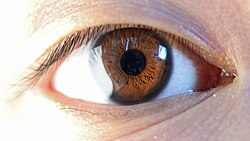Cornea
The cornea is the front part of the eye. It is the clear transparent section of the eye. The cornea covers the iris, pupil, and the eye chamber. It is a special form of tissue. The cornea is clear and has no blood vessels. It has nerves, but with no myelin sheaths on them.
| Cornea | |
|---|---|
 Schematic diagram of the human eye showing the cornea as separated from the sclera by the corneal limbus | |
| Details | |
| Part of | Front of eye |
| System | Visual system |
| Identifiers | |
| Latin | cornea |
| TH | |
| TE | |
| FMA | |
| Anatomical terminology | |
The cornea, with the lens, refracts light. The cornea and the lens bend light so the image strikes the retina. The cornea does about two-thirds of this refraction.[1][2]
Dua's layer is a newly discovered layer of the cornea. It was described in June 2013.[3] It is the sixth layer of the cornea to be discovered.[4][5] Despite its thinness, the layer is very strong, and air does not get through it.[3]
Cornea Media
References
| Wikimedia Commons has media related to Lua error in Module:Commons_link at line 62: attempt to index field 'wikibase' (a nil value).. |
- ↑ Cassin, Barbara; Solomon, Sheila A. B. (March 15, 1990). Rubin M.D., Melvin L. (ed.). Dictionary of eye terminology (2nd ed.). Gainsville, Florida: Triad Publishing Company. ISBN 978-0937404331.
- ↑ Goldstein, E. Bruce (2012). Sensation & perception (7th ed.). Canada: Thompson Wadsworth. ISBN 978-0878935727.
- ↑ 3.0 3.1 Dua H.S. et al 2013. Human corneal anatomy redefined: a novel pre-Descemet's layer (Dua's layer). Ophthalmology. Dua, Harminder S.; Faraj, Lana A.; Said, Dalia G.; Gray, Trevor; Lowe, James (2013). "Human Corneal Anatomy Redefined". Ophthalmology. 120 (9): 1778–1785. doi:10.1016/j.ophtha.2013.01.018. PMID 23714320.
- ↑ Olson, Samantha. New cornea layer discovered in human eye: doctors predict safer and simpler eye treatments. http://www.medicaldaily.com/articles/16508/20130613/new-cornea-layer-dua-layer-harminder-dua-indian-scientist-discovery-eye-discovery.htm. Retrieved 14 June 2013.
- ↑ "New layer of human eye,'Dua's layer', discovered behind cornea". Huffington Post Live Science. 12 June 2013. Retrieved June 13, 2013.



